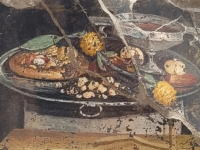News
The ancestor of pizza discovered in Pompeii
In a painting from 2,000 years ago
USPA NEWS -
An archaeological discovery has just cast doubt on the origin of pizza. This popular dish of Italian gastronomy, elevated in 2017 to the category of World Heritage, could have its origin in classical Rome. This is clear from the discovery of a fresco among the ruins of Pompeii, the city buried by the volcano Vesuvius in the year 79 AC.
The painting has been found in a house on Insula 10 of Regio IX of the excavation, located next to a bakery and which had been partially explored between 1888 and 1891. The exploration was resumed last January, discovering a fresco in the that appears a plate that seems to be a pizza. "Strictly speaking, it cannot be because some of the most characteristic ingredients are missing, such as tomato and mozzarella," says a spokesman for the excavation.
However, he adds, "as the initial iconographic analysis of the fresco with still life, which appeared during the new excavations, shows, what was represented on the wall of a Pompeian house could be a distant ancestor of this modern plate." According to those responsible for the excavation, what can be seen next to a glass of wine placed on a silver tray "is a flat focaccia that serves as a support for various fruits," among which a pomegranate has been identified and what appears to be a date.
"That focaccia was seasoned with spices or perhaps, rather, with a kind of pesto (moretum, in Latin), indicated by yellowish and ocher dots," explain those responsible for the excavation. And they add: "In addition, on the same tray there are nuts and a garland of yellow strawberry trees along with dates and pomegranates." These types of images, known in Antiquity as xenias, "were inspired by the 'hospitable gifts' offered to guests, according to a Greek tradition that dates back to Hellenistic times, between the 3rd and 1st centuries BC. Some are known 300 of these representations in the cities of Vesuvius, which often also allude to the sacred realm," the same sources point out.
For the Italian Minister of Culture, Gennaro Sangiuliano, "Pompeii never ceases to surprise, it is a chest that always reveals new treasures." The minister adds that "beyond the question of merit that scholars will talk about, the global value of this site to which we are dedicating our efforts must be underlined, with the closure of the Great Pompeii Project, but also with the launch of new initiatives. The protection and development of heritage, in accordance with article 9 of our Constitution, are an absolute priority."
Liability for this article lies with the author, who also holds the copyright. Editorial content from USPA may be quoted on other websites as long as the quote comprises no more than 5% of the entire text, is marked as such and the source is named (via hyperlink).






